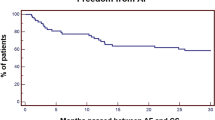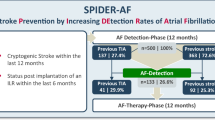Abstract
Background
In recent years, the implantable cardiac monitors (ICM) have enhanced the recognition ability of atrial fibrillation (AF), which makes ICM have a new application in AF detection. We conducted a meta-analysis to determine the total incidence of newly found AF detected by ICM after cryptogenic stroke and to evaluate the factors related to the detection of AF.
Methods
A literature search was conducted in the PubMed, EMBASE, Web of Science, and Cochrane library databases until March 1, 2020. Studies that reported the detection rate of AF using ICM in cryptogenic stroke patients with negative initial AF screening were analyzed.
Results
A total of 23 studies were included. The overall proportion of AF detected by ICM in cryptogenic stroke patients was 25% (95% confidence interval [CI], 22–29%). The rate of AF detected by ICM was independently related to both cardiac monitoring time (coefficient = 0.0003; 95% CI, 0.0001–0.0005; P = 0.0001) and CHA2DS2-VASc score (coefficient = 0.0834; 95% CI, 0.0339–0.1329; P = 0.001). In subgroup analysis, we found a significant difference in the detection rate of AF for monitoring duration (< 6 months: 9.6% [95% CI, 4.4–16.4%]; ≥ 6 and ≤ 12 months: 19.3% [95% CI, 15.9–23.0%]; > 12 and ≤ 24 months: 23.6% [95% CI, 19.9–27.5%]; > 24 months and ≤ 36 months: 36.5% [95% CI, 24.2–49.9%]; P < 0.001), and continent (Europe: 26.5% [95% CI, 22.2–31.0%]; North America: 16.0% [95% CI, 10.3–22.6%]; Asia: 17.4% [95% CI, 12.4–23.0%]; P = 0.005).
Conclusions
The longer the time of ICM monitoring after cryptogenic stroke, the higher the detection rate of AF. Further research is still needed to determine the optimal duration of long-term cardiac monitoring.



Similar content being viewed by others
References
Hart RG, Diener HC, Coutts SB, Easton JD, Granger CB, O'Donnell MJ, Sacco RL, Connolly SJ, Cryptogenic Stroke EIWG (2014) Embolic strokes of undetermined source: the case for a new clinical construct. Lancet Neurol 13(4):429–438. https://doi.org/10.1016/S1474-4422(13)70310-7
Saver JL (2016) CLINICAL PRACTICE. Cryptogenic Stroke. N Engl J Med 374(21):2065–2074. https://doi.org/10.1056/NEJMcp1503946
Kolominsky-Rabas PL, Weber M, Gefeller O, Neundoerfer B, Heuschmann PU (2001) Epidemiology of ischemic stroke subtypes according to TOAST criteria: incidence, recurrence, and long-term survival in ischemic stroke subtypes: a population-based study. Stroke 32(12):2735–2740. https://doi.org/10.1161/hs1201.100209
Tsang TS, Petty GW, Barnes ME, O'Fallon WM, Bailey KR, Wiebers DO, Sicks JD, Christianson TJ, Seward JB, Gersh BJ (2003) The prevalence of atrial fibrillation in incident stroke cases and matched population controls in Rochester, Minnesota: changes over three decades. J Am Coll Cardiol 42(1):93–100. https://doi.org/10.1016/s0735-1097(03)00500-x
Wolf PA, Abbott RD, Kannel WB (1991) Atrial fibrillation as an independent risk factor for stroke: the Framingham Study. Stroke 22(8):983–988. https://doi.org/10.1161/01.str.22.8.983
Sanna T, Diener HC, Passman RS, Di Lazzaro V, Bernstein RA, Morillo CA, Rymer MM, Thijs V, Rogers T, Beckers F, Lindborg K, Brachmann J, Investigators CA (2014) Cryptogenic stroke and underlying atrial fibrillation. N Engl J Med 370(26):2478–2486. https://doi.org/10.1056/NEJMoa1313600
Sposato LA, Cipriano LE, Saposnik G, Ruiz Vargas E, Riccio PM, Hachinski V (2015) Diagnosis of atrial fibrillation after stroke and transient ischaemic attack: a systematic review and meta-analysis. Lancet Neurol 14(4):377–387. https://doi.org/10.1016/S1474-4422(15)70027-X
Strickberger SA, Ip J, Saksena S, Curry K, Bahnson TD, Ziegler PD (2005) Relationship between atrial tachyarrhythmias and symptoms. Heart Rhythm 2(2):125–131. https://doi.org/10.1016/j.hrthm.2004.10.042
Healey JS, Connolly SJ, Gold MR, Israel CW, Van Gelder IC, Capucci A, Lau CP, Fain E, Yang S, Bailleul C, Morillo CA, Carlson M, Themeles E, Kaufman ES, Hohnloser SH, Investigators A (2012) Subclinical atrial fibrillation and the risk of stroke. N Engl J Med 366(2):120–129. https://doi.org/10.1056/NEJMoa1105575
Charitos EI, Stierle U, Ziegler PD, Baldewig M, Robinson DR, Sievers HH, Hanke T (2012) A comprehensive evaluation of rhythm monitoring strategies for the detection of atrial fibrillation recurrence: insights from 647 continuously monitored patients and implications for monitoring after therapeutic interventions. Circulation 126(7):806–814. https://doi.org/10.1161/CIRCULATIONAHA.112.098079
Etgen T, Hochreiter M, Mundel M, Freudenberger T (2013) Insertable cardiac event recorder in detection of atrial fibrillation after cryptogenic stroke: an audit report. Stroke 44(7):2007–2009. https://doi.org/10.1161/STROKEAHA.113.001340
Burkowitz J, Merzenich C, Grassme K, Bruggenjurgen B (2016) Insertable cardiac monitors in the diagnosis of syncope and the detection of atrial fibrillation: a systematic review and meta-analysis. Eur J Prev Cardiol 23(12):1261–1272. https://doi.org/10.1177/2047487316632628
Ritter MA, Kochhauser S, Duning T, Reinke F, Pott C, Dechering DG, Eckardt L, Ringelstein EB (2013) Occult atrial fibrillation in cryptogenic stroke: detection by 7-day electrocardiogram versus implantable cardiac monitors. Stroke 44(5):1449–1452. https://doi.org/10.1161/STROKEAHA.111.676189
Cotter PE, Martin PJ, Ring L, Warburton EA, Belham M, Pugh PJ (2013) Incidence of atrial fibrillation detected by implantable loop recorders in unexplained stroke. Neurology 80(17):1546–1550. https://doi.org/10.1212/WNL.0b013e31828f1828
Christensen LM, Krieger DW, Hojberg S, Pedersen OD, Karlsen FM, Jacobsen MD, Worck R, Nielsen H, Aegidius K, Jeppesen LL, Rosenbaum S, Marstrand J, Christensen H (2014) Paroxysmal atrial fibrillation occurs often in cryptogenic ischaemic stroke. Final results from the SURPRISE study. Eur J Neurol 21(6):884–889. https://doi.org/10.1111/ene.12400
Yushan B, Tan BYQ, Ngiam NJ, Chan BPL, Luen TH, Sharma VK, Sia CH, Dalakoti M, Chong SS, Kojodjojo P, Yeo LLL (2019) Association between bilateral infarcts pattern and detection of occult atrial fibrillation in embolic stroke of undetermined source (ESUS) patients with insertable cardiac monitor (ICM). J Stroke Cerebrovasc Dis 28(9):2448–2452. https://doi.org/10.1016/j.jstrokecerebrovasdis.2019.06.025
Jorfida M, Antolini M, Cerrato E, Caprioli MG, Castagno D, Garrone P, Budano C, Cerrato P, Gaita F (2016) Cryptogenic ischemic stroke and prevalence of asymptomatic atrial fibrillation: a prospective study. J Cardiovasc Med (Hagerstown) 17(12):863–869. https://doi.org/10.2459/JCM.0000000000000181
De Angelis MV, Di Stefano V, Franciotti R, Furia N, Di Girolamo E, Onofrj M, Faustino M (2020) Cryptogenic stroke and atrial fibrillation in a real-world population: the role of insertable cardiac monitors. Sci Rep 10(1):3230. https://doi.org/10.1038/s41598-020-60180-6
Israel C, Kitsiou A, Kalyani M, Deelawar S, Ejangue LE, Rogalewski A, Hagemeister C, Minnerup J, Schabitz WR (2017) Detection of atrial fibrillation in patients with embolic stroke of undetermined source by prolonged monitoring with implantable loop recorders. Thromb Haemost 117(10):1962–1969. https://doi.org/10.1160/TH17-02-0072
Milstein NS, Musat DL, Allred J, Seiler A, Pimienta J, Oliveros S, Bhatt AG, Preminger M, Sichrovsky T, Shaw RE, Mittal S (2020) Detection of atrial fibrillation using an implantable loop recorder following cryptogenic stroke: implications for post-stroke electrocardiographic monitoring. J Interv Card Electrophysiol 57(1):141–147. https://doi.org/10.1007/s10840-019-00628-6
Bettin M, Dechering D, Kochhauser S, Bode N, Eckardt L, Frommeyer G, Reinke F (2019) Extended ECG monitoring with an implantable loop recorder in patients with cryptogenic stroke: time schedule, reasons for explantation and incidental findings (results from the TRACK-AF trial). Clin Res Cardiol 108(3):309–314. https://doi.org/10.1007/s00392-018-1358-4
Iwata T, Todo K, Yamagami H, Morimoto M, Hashimoto T, Doijiri R, Furuya H (2019) High detection rate of atrial fibrillation with insertable cardiac monitor implantation in patients with cryptogenic stroke diagnosed by magnetic resonance imaging. J Stroke Cerebrovasc Dis 28(9):2569–2573. https://doi.org/10.1016/j.jstrokecerebrovasdis.2019.05.023
Makimoto H, Kurt M, Gliem M, Lee JI, Schmidt J, Muller P, Clasen L, Brinkmeyer C, Shin DI, Jander S, Kelm M, Furnkranz A (2017) High incidence of atrial fibrillation after embolic stroke of undetermined source in posterior cerebral artery territory. J Am Heart Assoc 6(12):e007448. https://doi.org/10.1161/JAHA.117.007448
Seow SC, How AK, Chan SP, Teoh HL, Lim TW, Singh D, Yeo WT, Kojodjojo P (2018) High incidence of occult atrial fibrillation in asian patients with cryptogenic stroke. J Stroke Cerebrovasc Dis 27(8):2182–2186. https://doi.org/10.1016/j.jstrokecerebrovasdis.2018.03.019
Pecha S, Wilke I, Yildirim Y, Reichenspurner H, Aydin MA (2020) Implantable loop recorder monitoring in patients with cryptogenic stroke - detection and treatment of different clinically relevant arrhythmias. J Electrocardiol 60:102–106. https://doi.org/10.1016/j.jelectrocard.2020.04.007
Victor CU, Carolina PE, Jorge TR, Joaquin CR, Manuel SG, Marta CM, Jose Maria FV, Chinh PT, Javier OM, Susana MS, Sanchez Diego J, Carlos JO, Ignacio FL (2018) Incidence and predictive factors of hidden atrial fibrillation detected by implantable loop recorder after an embolic stroke of undetermined source. J Atr Fibrillation 11(3):2078. https://doi.org/10.4022/jafib.2078
Poli S, Diedler J, Hartig F, Gotz N, Bauer A, Sachse T, Muller K, Muller I, Stimpfle F, Duckheim M, Steeg M, Eick C, Schreieck J, Gawaz M, Ziemann U, Zuern CS (2016) Insertable cardiac monitors after cryptogenic stroke--a risk factor based approach to enhance the detection rate for paroxysmal atrial fibrillation. Eur J Neurol 23(2):375–381. https://doi.org/10.1111/ene.12843
Ziegler PD, Rogers JD, Ferreira SW, Nichols AJ, Richards M, Koehler JL, Sarkar S (2017) Long-term detection of atrial fibrillation with insertable cardiac monitors in a real-world cryptogenic stroke population. Int J Cardiol 244:175–179. https://doi.org/10.1016/j.ijcard.2017.06.039
Carrazco C, Golyan D, Kahen M, Black K, Libman RB, Katz JM (2018) Prevalence and risk factors for paroxysmal atrial fibrillation and flutter detection after cryptogenic ischemic stroke. J Stroke Cerebrovasc Dis 27(1):203–209. https://doi.org/10.1016/j.jstrokecerebrovasdis.2017.08.022
Asaithambi G, Monita JE, Annamalai MR, Ho BM, Marino EH, Hanson SK (2018) Prevalence of atrial fibrillation with insertable cardiac monitors in cryptogenic stroke: a single-center experience. J Electrocardiol 51(6):973–976. https://doi.org/10.1016/j.jelectrocard.2018.08.033
Ziegler PD, Rogers JD, Ferreira SW, Nichols AJ, Sarkar S, Koehler JL, Warman EN, Richards M (2015) Real-world experience with insertable cardiac monitors to find atrial fibrillation in cryptogenic stroke. Cerebrovasc Dis 40(3-4):175–181. https://doi.org/10.1159/000439063
Cuadrado-Godia E, Benito B, Ois A, Valles E, Rodriguez-Campello A, Giralt-Steinhauer E, Cabrera S, Alcalde O, Jimenez-Lopez J, Jimenez-Conde J, Marti-Almor J, Roquer J (2020) Ultra-early continuous cardiac monitoring improves atrial fibrillation detection and prognosis of patients with cryptogenic stroke. Eur J Neurol 27(2):244–250. https://doi.org/10.1111/ene.14061
Dion F, Saudeau D, Bonnaud I, Friocourt P, Bonneau A, Poret P, Giraudeau B, Régina S, Fauchier L, Babuty D (2010) Unexpected low prevalence of atrial fibrillation in cryptogenic ischemic stroke: a prospective study. J Interv Card Electrophysiol 28(2):101–107. https://doi.org/10.1007/s10840-010-9485-5
Reiffel JA (2014) Atrial fibrillation and stroke: epidemiology. Am J Med 127(4):e15–e16. https://doi.org/10.1016/j.amjmed.2013.06.002
Jickling GC, Stamova B, Ander BP, Zhan X, Liu D, Sison SM, Verro P, Sharp FR (2012) Prediction of cardioembolic, arterial, and lacunar causes of cryptogenic stroke by gene expression and infarct location. Stroke 43(8):2036–2041. https://doi.org/10.1161/STROKEAHA.111.648725
Tsivgoulis G, Katsanos AH, Kohrmann M, Caso V, Perren F, Palaiodimou L, Deftereos S, Giannopoulos S, Ellul J, Krogias C, Mavridis D, Triantafyllou S, Alexandrov AW, Schellinger PD, Alexandrov AV (2019) Duration of implantable cardiac monitoring and detection of atrial fibrillation in ischemic stroke patients: a systematic review and meta-analysis. J Stroke 21(3):302–311. https://doi.org/10.5853/jos.2019.01067
Dahal K, Chapagain B, Maharjan R, Farah HW, Nazeer A, Lootens RJ, Rosenfeld A (2016) Prolonged cardiac monitoring to detect atrial fibrillation after cryptogenic stroke or transient ischemic attack: a meta-analysis of randomized controlled trials. Ann Noninvasive Electrocardiol 21(4):382–388. https://doi.org/10.1111/anec.12319
Ueno Y, Tateishi Y, Doijiri R, Kuriki A, Shimizu T, Kikuno M, Shimada Y, Takekawa H, Yamaguchi E, Koga M, Kamiya Y, Ihara M, Tsu**o A, Hirata K, Toyoda K, Hasegawa Y, Hattori N, Urabe T (2019) Large aortic arch plaques correlate with CHADS2 and CHA2DS2-VASc scores in cryptogenic stroke. Atherosclerosis 284:181–186. https://doi.org/10.1016/j.atherosclerosis.2019.03.009
Renda G, Ricci F, Patti G, Aung N, Petersen SE, Gallina S, Hamrefors V, Melander O, Sutton R, Engstrom G, Caterina R, Fedorowski A (2019) CHA2DS2VASc score and adverse outcomes in middle-aged individuals without atrial fibrillation. Eur J Prev Cardiol 26(18):1987–1997. https://doi.org/10.1177/2047487319868320
Funding
This work was supported by the National Key Research and Development Program of China (2017YFC0114300); the National Basic Research Priorities Program of Jiangsu Province (Grant No. BK20160347); the Jiangsu Province’s Key Provincial Talents Program (Grant No. QNRC2016730); and the Health and Family Planning Commission of Jiangsu Province (Grant No. Z2017011).
Author information
Authors and Affiliations
Corresponding authors
Ethics declarations
All the authors read and approved the final version of the manuscript for publication.
Conflict of interest
The authors have no competing interests.
Ethical approval
None.
Informed consent
None.
Additional information
Publisher’s note
Springer Nature remains neutral with regard to jurisdictional claims in published maps and institutional affiliations.
Supplementary information
ESM 1
(DOCX 598 kb)
Rights and permissions
About this article
Cite this article
Lu, Y., Diao, Ss., Huang, Sj. et al. Insertable cardiac monitors for detection of atrial fibrillation after cryptogenic stroke: a meta-analysis. Neurol Sci 42, 4139–4148 (2021). https://doi.org/10.1007/s10072-021-05104-6
Received:
Accepted:
Published:
Issue Date:
DOI: https://doi.org/10.1007/s10072-021-05104-6




